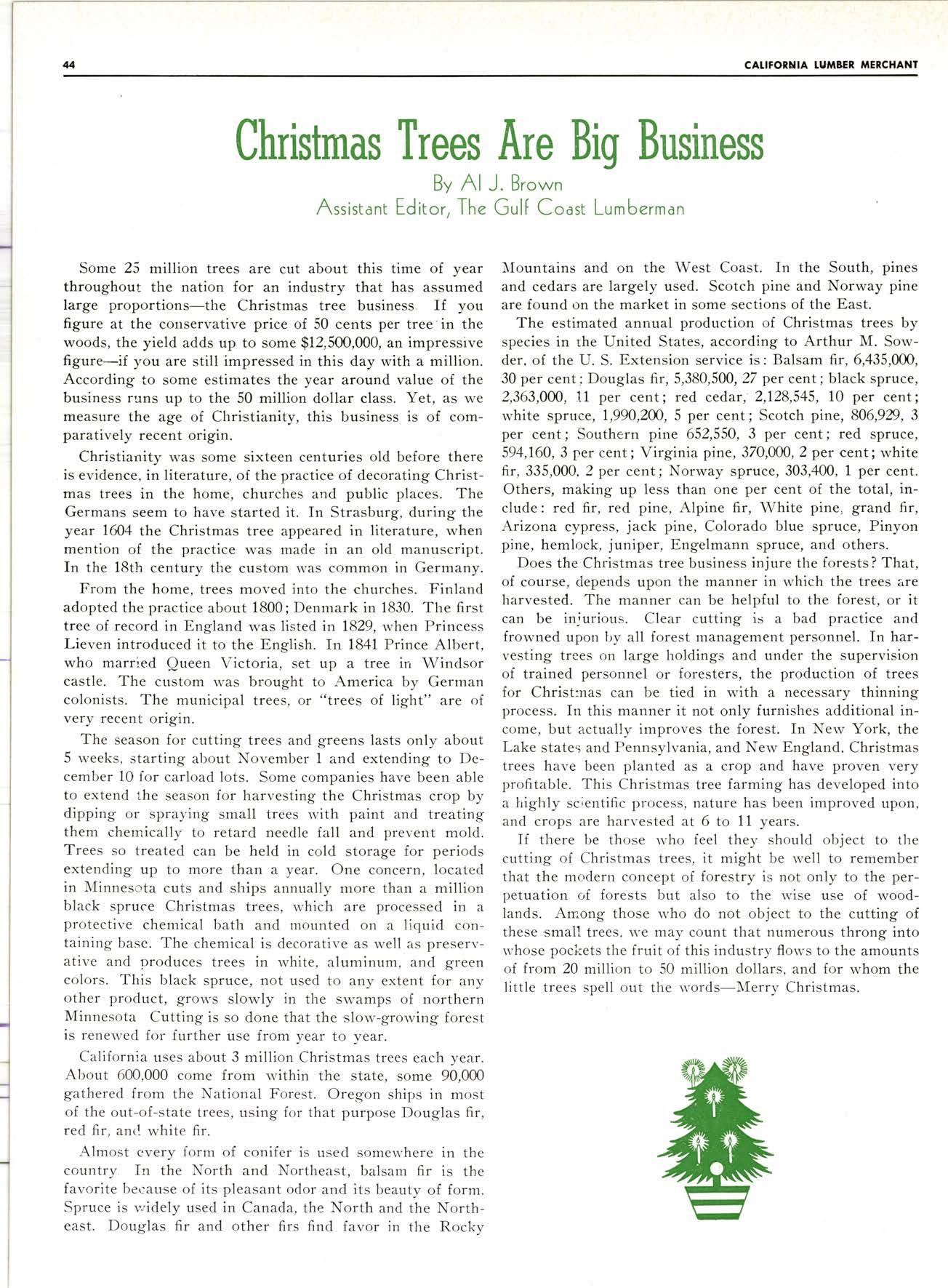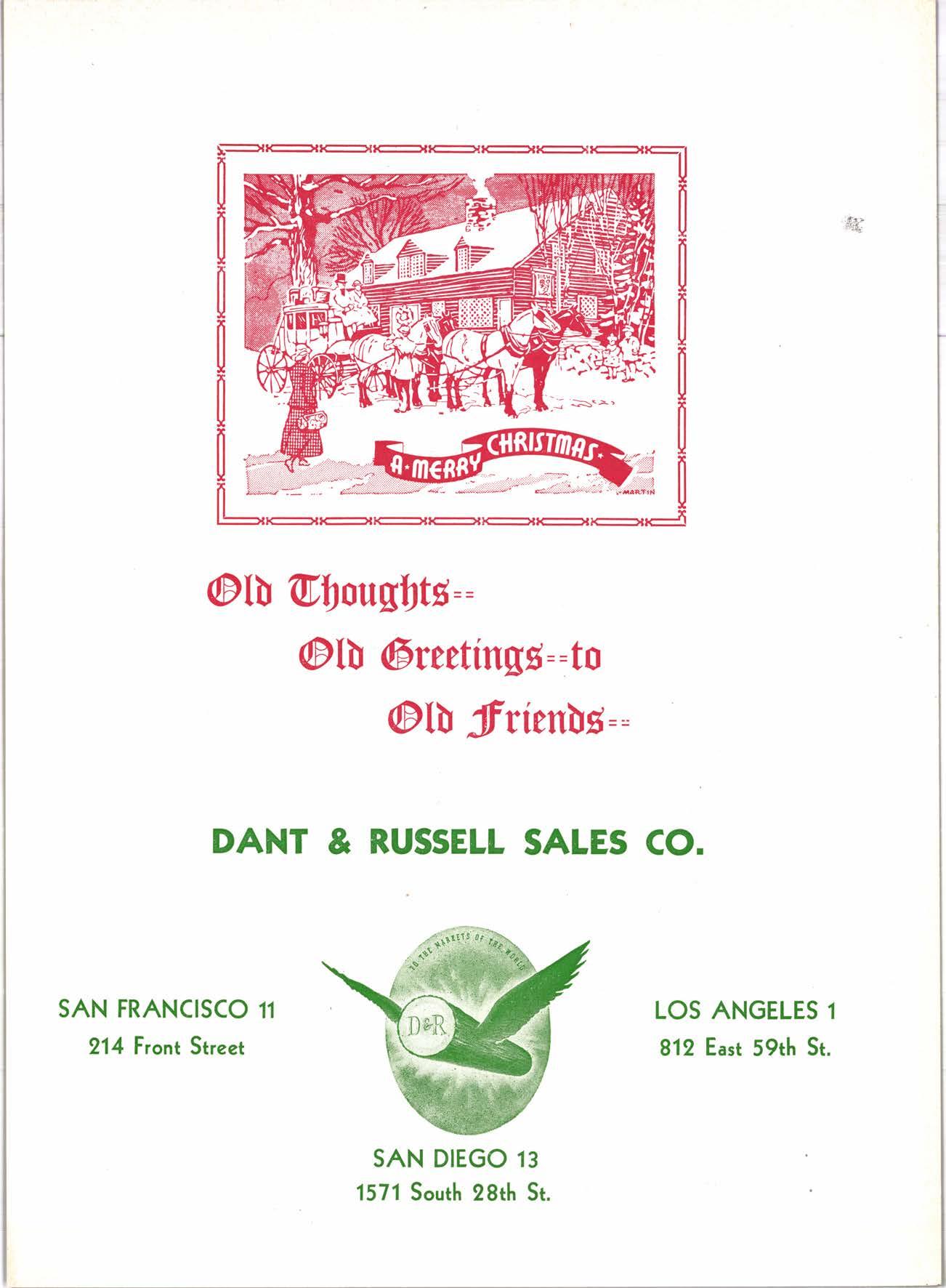
3 minute read
Christmas Trees Are Biq Business
Bv Al J. Brown Assistant Editor, The Gulf Coast Lumberman
Some 25 million trees are cut about this time of year throughout the nation for an industry that has assumed large proportions-the Christmas tree business. If you figure at the conservative price of 50 cents per tree'in the woods, the yield adds up to some $12,500,000, an impressive figure-if you are still impressed in this day with a million. According to some estimates the year around value of the business runs up to the 50 million dollar class. Yet, as rlre measure the age of Christianity, this business is of comparatively recent origin.
Christianity was some sixteen centuries old before there is evidence, in literature, of the practice of decorating Christmas trees in the home, churches and public places. The Germans seem to have started it. In Strasburg, during the year 1604 the Christmas tree appeared in literature, when mention of the practice was made in an old manuscript. In the 18th century the custom was common in Germany.
From the home, trees moved into the churches. Finland adopted the practice about 1800;Denmark in 1830. The first tree of record in England was listed in 1829, when Princess Lieven introduced it to the English. In 1841 Prince Albert, who married Queen Victoria, set up a tree ir, Windsor castle. The custom was brought to America by German colonists. The municipal trees, or "trees of light" are of very recent origin.
The season for cutting trees and greens lasts only about 5 weeks, starting about November 1 and extending to December 10 for carload lots. Some companies have been able to extend lhe season for harvesting the Christmas crop by dipping or spraying small trees with paint and treating them chemically to retard needle fall and prevent mold. Trees so treated can be held in cold storage for periods extending up to more than a year. One concern, located in Minnesota cuts and ships annually more than a million black spruce Christmas trees, which are processed in a protective chemical bath and mounted on a liquid containing basc. The chemical is decorative as well as preservative and produces trees in white, aluminum, and green colors. This black spruce, not used to any extent for any other product, grows slowly in the swamps of northern Minnesota Cutting is so done that the slow-growing forest is renewed for further use from year to year.
California uses about 3 million Christmas trees each year. About 600,000 come from within the state, some 90,000 gathered from the National Forest. Oregon ships in most of the out-of-state trees, using for that purpose Douglas fir, red fir, ancl white fir.
Almost cvery form of conifer is used somewhere in the country. In the North and Northeast, balsam fir is the favorite because of its pleasant odor and its beauty of form. Spruce is r.videly used in Canada, the North and the Northeast. Douglas fir and other firs find favor in the Rocky
Mountains and on the West Coast. In the South, pines and cedars are largely used. Scotch pine and Norway pine are found on the market in some sections of the East.
The estimated annual production of Christmas trees by species in the United States, according to Arthur I\[. Sowder, of the U. S. Extension service is: Ralsam fir, 6,435,000, 30 per cent: Douglas fir, 5,380,500, 27 per cent; black spruce, 2,363,0N, 11 per cent; red cedar,' 2,128,545, 10 per cent; white spruce, 1,990,26, 5 per cent; Scotch pine, 806,9n,3 per cent; Southern pine 652,550, 3 per cent; red spruce, 594,160,3 per cent ; Virginia pine, 370,000, 2 per cent; white fir, 335,000. 2 per cent; Norway spruce, 303,400, I per cent. Others, making up less than one per cent of the total, include: red fir, red pine, Alpine fir, White pine, grand fir, Arizona cypress, jack pine, Colorado blue spruce, Pinyon pine, hemlock, juniper, Engelmann spruce, and others.
Does the Christmas tree business injure the forests? That, of course, depends upon the manner in which the trees are harvested. The manner can be helpful to the forest, or it can be iniurious. Clear cutting is a bad practice and frowned upon by all forest management personnel. In harvesting trees on large holdings and under the supervision of trained personnel or foresters, the production of trees for Christ:nas can be tied in with a necessary thinning process. In this manner it not only furnishes additional income, but actually improves the forest. In New York, the Lake states and Pennsylvania, and New England. Christmas trees have been planted as a crop and have proven very profitable. This Christmas tree farming has developed into a highly screntific process, nature has been improved upon, and crops are harvested at 6 to 11 years.
If there be those rvho feel they should object to the cutting of Christmas trees, it might be well to remember that the modern concept of forestry is not only to the perpetuation of forests but also to the wise use of woodlands. Arnong those who do not otrject to the cutting of these small trees. we may count that numerous throng into whose pockets the fruit of this industry flows to the amounts of from 20 million to 50 million dollars, and for whom the little trees spell out the words-Merry Christmas.











